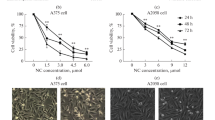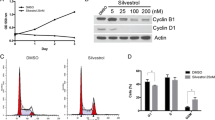Abstract
Pseudolaric acid B is a major compound found in the bark ofPseudolarix kaempferi Gordon. In our study, pseudolaric acid B inhibited growth of human melanoma cells, A375-S2 in a time-and dose-dependent manner. A375-S2 cells treated with pseudolaric acid B showed typical characteristics of apoptosis including morphologic changes, DNA fragmentation, sub-diploid peak in flow cytometry, cleavage of poly-ADP ribose polymerase (PARP) and degradation of inhibitor of caspase-activated DNase (ICAD). P53 protein expression was upregulated while cells were arrested at the G2/M phase of the cell cycle. There was a decrease in the expression of anti-apoptotic Bcl-2 and Bcl-xL proteins, whereas pro-apoptotic Bax was increased. The two classical caspase substrates, PARP and ICAD, were both decreased in a time-dependent manner, indicating the activation of downstream caspases.
Similar content being viewed by others
References
Agarwal, N. and Mehta, K., Possible involvement of Bcl-2 pathway in retinoid X receptor alpha-induced apoptosis of HL-60 cells.Biochem. Biophys. Res. Comm., 230, 251–253 (1997).
Enari, M., Sakahira, H., Yokoyama, H., Okawa, K., Iwamatsu, A., and Nagata, S., A., Caspase-activated DNase that degrades DNA during apoptosis, and its inhibitor ICAD.Nature, 391, 43–50 (1998).
Hermeking, H., Lengauer, C., Polyak, K., He, T. C., Zhang, L., Thiagalingam, S., Kinzler, K. W., and Vogelstein, B., 14-3-3-Sigma is a p53-regulated inhibitor of G2/M progression.Mol. Cell, 1, 3–11 (1997).
Hockenbery, D. M., Oltvai, Z. N., Yin, X. M., Milliman, C. L., and Korsmeyer, S. J., Bcl-2 functions in an antioxidant pathway to prevent apoptosis.Cell, 75, 241–251 (1993).
Kastan, M.B., Onyekwere, O., Sidransky, D., Vogelstein, B., and Craig, R.W., Participation of p53 protein in cellular response to DNA damage.Cancer Res., 51, 6304–6311 (1991).
Kerr, J.F., Wyllie, A.H., and Currie, A.R., Apoptosis: a basic biologic phenomenon with wide-ranging implications in tissue kinetics.Br. J. Cancer, 26, 239–257 (1972).
Lane, D.P., p53, guardian of the genome.Nature, 258, 15–16 (1992).
Lazebnik, Y. A., Kaufmann, S. H., Desnoyers, S., Poirier, G. G., and Earnshaw, W. C., Cleavage of poly (ADP-ribose) polymerase by a proteinase with properties like ICE.Nature, 371, 346–347 (1994).
Li, E., Clark, A. M., and Hufford, C. D., Antifungal evaluation of pseudolaric acid B, a major constituent ofpseudolarix kaempferi.J. Nat. Prod., 58, 57–67 (1995).
Liu, X. S., Zou, H., Slaughter, C., and Wang, X., DFF, a heterodimeric protein that functions downstream of caspase-3 to trigger DNA fragmentation during apoptosis.Cell, 89, 175–184 (1997).
Mengubas, K., Riordan, F. A., Hoffbrand, V., and Wickremasinghe, G., Co-ordinated downregulation of Bcl-2 and Bax expression during granulocytic and macrophage-like differentiation of the HL60 premyelocytic leukemia cell line.FEBS. Lett., 394, 356–360 (1996).
Nicholson, D. W., Ali, A., Thomberry, N. A., Vaillancourt, J. P., Ding, C. K., Gallant, M., Gareau, Y., Griffin, P. R., Labelle, M., and Lazebnik, Y. A., Identification and inhibition of the ICE/ CED-3 protease necessary for mammalian apoptosis.Nature, 376, 37–43 (1995).
Pan, D. J., Li, Z. L., Hu, C. Q., Chen, K., Chang, J. J., and Lee, K. H., The cytotoxic principles ofPseudolarix Kaempferi: Pseudolaric acid-A and B and related derivatives.Planta Med., 56, 383–385 (1990).
Sakahira, H., Enari, M., and Nagata, S., Cleavage of CAD inhibitor in CAD activation and DNA degradation during apoptosis.Nature, 391, 96–99 (1998).
Schwartz, D., Almong, N., Peled, A., Goldfinger, N., and Rotter, V., Role of wild-type p53 in the G2 phase: regulation of the α-irradiation induced delay and DNA repair.Oncogene, 15, 2597–2607 (1997).
Stewart, N., Hicks, G. G., Paraskevans, F., and Mowat, M., Evidence for a second cell cycle block at G2/M by p53.Oncogene, 10, 109–115 (1995).
Taylor, W.R., and Stark, G.R., Regulation of the G2/M transition by p53.Oncogene, 20, 1803–1815 (2001).
Wang, W. C., Lu, R.F., Zhao, S. X., and Gu, Z. P., Comparison of early pregnancy-terminating effect and toxicity between pseudolaric acids A and B.Acta. Pharmacol. Sin., 9, 445–448 (1988).
Wang, W. C., Lu, R. F., Zhao, S. X., and Zhu, Y. Z., Antifertility effect of pseudolaric acid B.Acta. Pharmacol. Sin., 3, 188–192 (1982).
Wu, L. X., Xu, J. H., Wu, G. H., and Chen, Y. Z., Inhibitory effect of curcumin on proliferation of K562 cells involves down-regulation of p210bcr/abl-initiated Ras signal transduction pathway.Acta. Pharmacol. Sin., 11, 1155–1160 (2003).
Yue, T. L., Ohlstein, H. E., and Ruffolo, R. R., Apoptosis: a potential target for discovering novel therapies for cardiovascular diseases.Curr. Opin. Chem. Biol., 3, 474–480 (1999).
Author information
Authors and Affiliations
Corresponding author
Rights and permissions
About this article
Cite this article
Gong, XF., Wang, MW., Tashiro, SI. et al. Pseudolaric acid B induces apoptosis through p53 and bax/ Bcl-2 pathways in human melanoma a375-s2 cells. Arch Pharm Res 28, 68–72 (2005). https://doi.org/10.1007/BF02975138
Received:
Issue Date:
DOI: https://doi.org/10.1007/BF02975138




